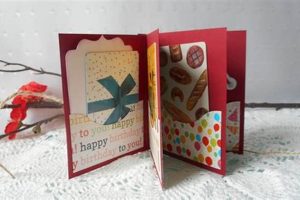Handcrafted holiday presents for colleagues represent a thoughtful gesture of appreciation during the festive season. These personalized creations offer an alternative to conventional store-bought items, conveying a sense of care and effort often valued in professional relationships. Examples range from baked goods and small desk organizers to customized stationery and potted plants.
The act of providing unique, homemade holiday tokens fosters a positive and collaborative work environment. Such offerings can improve morale and strengthen bonds between individuals, contributing to a more cohesive team dynamic. Historically, the exchange of small gifts during the year-end holidays has been a common practice, signifying goodwill and recognizing contributions made throughout the year.
The subsequent sections will elaborate on various project ideas suitable for crafting such holiday presents, encompassing diverse skill levels and budgets. These suggestions aim to inspire individuals seeking to create memorable and meaningful gifts for their work associates.
Crafting Memorable Handcrafted Holiday Presents for Colleagues
This section outlines fundamental considerations for creating personalized holiday gifts, ensuring thoughtfulness and appropriateness within the professional setting.
Tip 1: Prioritize Functionality: Opt for gift ideas that serve a practical purpose in the workplace, such as desk organizers, personalized stationery, or reusable coffee filters. This increases the likelihood that the gift will be utilized and appreciated.
Tip 2: Adhere to Workplace Etiquette: Ensure that the gift is appropriate for the office environment and adheres to any established gift-giving policies. Avoid items that are overly personal, extravagant, or potentially offensive.
Tip 3: Personalize Thoughtfully: Incorporate elements that reflect the recipient’s interests or professional role. This could involve using their favorite colors, adding their initials, or tailoring the gift to their specific job function.
Tip 4: Maintain Budgetary Restraint: Establish a reasonable budget for each gift and adhere to it. The value lies in the thoughtfulness and effort invested, not in the monetary cost.
Tip 5: Focus on Presentation: The packaging and presentation of the gift are crucial. Invest in attractive wrapping paper, ribbons, or gift bags to enhance the overall impression.
Tip 6: Time Management is Key: Begin the crafting process well in advance of the holiday season to avoid unnecessary stress and ensure sufficient time for completion.
Tip 7: Quality over Quantity: Prioritize crafting a smaller number of high-quality, well-executed gifts over producing a larger quantity of subpar items.
Thoughtful preparation and execution enhance the impact of handcrafted gifts, fostering a positive and appreciative atmosphere within the workplace. Prioritizing these considerations demonstrates genuine care and respect for colleagues.
The subsequent section will delve into specific gift project ideas, building upon these foundational tips.
1. Appropriateness
The element of appropriateness forms a critical cornerstone in the creation and distribution of handcrafted holiday presents within the professional sphere. The selection of a project, the materials employed, and the overall design must align with established workplace norms and sensitivities. A failure to consider this aspect can engender discomfort, misinterpretation, or even offense, undermining the intended positive effect. For example, a personalized gag gift intended as humorous may be misconstrued as inappropriate or unprofessional, particularly if it touches upon sensitive subjects or relies on inside jokes not universally understood.
The importance of appropriateness extends beyond the selection of the gift itself to encompass its presentation and delivery. Gifts should be exchanged discreetly, avoiding any appearance of favoritism or preferential treatment. Furthermore, the value of the gift should remain within a modest range, preventing any perception of bribery or undue influence. In regulated industries, gifts of even nominal value might be subject to scrutiny, necessitating a cautious approach. Examples include homemade food items, which, while potentially appreciated, should be prepared in accordance with food safety regulations and with consideration for dietary restrictions or allergies.
In summary, ensuring appropriateness in the context of handcrafted holiday presents necessitates careful consideration of workplace culture, individual sensitivities, and relevant regulations. Thoughtful selection and presentation mitigate the risk of misinterpretation and contribute to a positive and inclusive environment. Understanding and adhering to these principles transform a potentially problematic gesture into a genuine expression of appreciation and camaraderie. Neglecting this aspect can inadvertently create unintended consequences, ultimately detracting from the goodwill such gifts are intended to foster.
2. Personalization
Personalization forms a critical element in the creation of do-it-yourself holiday presents for colleagues, enhancing their impact and demonstrating genuine thoughtfulness. By tailoring gifts to individual preferences and professional roles, the gesture becomes more meaningful and memorable.
- Reflecting Individual Interests
Incorporating hobbies, passions, or interests into the gift design showcases a deeper understanding of the recipient. For example, a colleague who enjoys gardening might appreciate a handcrafted seed starter kit, while a photography enthusiast could benefit from a personalized camera strap. This demonstrates attention to detail and strengthens the connection between giver and recipient.
- Acknowledging Professional Contributions
Tailoring a gift to recognize a colleague’s specific skills or accomplishments within the workplace serves as a form of appreciation and validation. A personalized desk organizer for a detail-oriented project manager or a custom-engraved pen for a proficient writer exemplifies this approach. The recognition of their professional contributions fosters a sense of value and belonging.
- Incorporating Shared Experiences
Gifts that allude to shared experiences within the team or workplace can create a sense of camaraderie and strengthen group bonds. A framed photo of a successful team project or a custom-made calendar featuring inside jokes fosters a shared identity and positive associations. This approach reinforces the collective experience and promotes a sense of unity.
- Customizing Functionality
Adapting the functionality of a gift to meet specific individual needs ensures its practicality and usefulness. A reusable coffee cup with a personalized design for a caffeine-dependent colleague or a hand-knit scarf in their favorite colors demonstrates consideration for their daily routine and preferences. This approach maximizes the likelihood that the gift will be appreciated and utilized.
Personalization, when thoughtfully executed, transforms a simple handmade gift into a meaningful token of appreciation, strengthening professional relationships and fostering a positive work environment. By considering individual preferences, professional contributions, shared experiences, and functional needs, the impact of the gift is significantly amplified. These personalized touches demonstrate genuine care and respect, making the holiday season more enjoyable for all involved.
3. Functionality
The practical value of a do-it-yourself holiday present for colleagues is significantly influenced by its inherent functionality. A gift that serves a purpose within the professional environment or contributes to the recipient’s daily routine is more likely to be utilized and appreciated than a purely decorative item. The direct correlation between functionality and perceived value dictates the gift’s long-term impact and serves as a tangible reminder of the giver’s thoughtfulness. For instance, a handcrafted desk organizer addresses the practical need for workspace tidiness, while a set of personalized coffee coasters protects surfaces and adds a touch of individual style to the office. The utility of these items contributes to their enduring presence and positive association.
The integration of functionality also encourages resourcefulness and creativity in the crafting process. Instead of solely focusing on aesthetic appeal, the emphasis shifts to designing items that offer practical solutions or enhance existing workflows. Examples include custom-labeled spice blends for a colleague who enjoys cooking, or a knitted laptop sleeve providing protection during commutes. These projects demonstrate an understanding of the recipient’s needs and a commitment to creating a gift that genuinely improves their daily experience. The selection of durable materials and robust construction techniques further enhances the longevity and functional effectiveness of these presents.
In conclusion, functionality is a key determinant of the success and impact of handcrafted holiday gifts for coworkers. By prioritizing practicality and designing items that serve a purpose, individuals can create presents that are not only appreciated but also actively utilized, fostering a positive and lasting impression within the professional sphere. The thoughtful consideration of functionality elevates the gift from a mere gesture to a tangible expression of care and understanding, strengthening workplace relationships and contributing to a more cohesive and productive environment.
4. Budget
Budgetary constraints exert a significant influence on the feasibility and scope of handcrafted holiday gifts intended for professional colleagues. Financial limitations necessitate resourcefulness and creativity in gift selection and creation, requiring a strategic approach to materials and labor.
- Material Sourcing and Cost Optimization
The availability and price of raw materials directly impact the overall cost of each gift. Repurposing existing materials, such as fabric scraps or reclaimed wood, can substantially reduce expenses. Bulk purchasing of supplies, where feasible, allows for economies of scale and minimizes per-unit costs. For example, purchasing a large roll of craft paper instead of individual sheets drastically reduces the cost per gift wrapping.
- Skill-Based Project Selection
The time investment required for more complex crafts translates to an indirect cost. Choosing projects that align with existing skill sets minimizes the learning curve and reduces the risk of material wastage due to errors. Simpler projects, such as personalized handwritten notes or decorated mason jars, require less specialized expertise and are generally more time-efficient to produce in bulk.
- Prioritization of Value over Extravagance
The perceived value of a gift does not necessarily correlate with its monetary cost. Thoughtful gestures, such as homemade baked goods or handwritten letters, can be highly appreciated despite their low financial investment. Focusing on the sentiment and effort involved, rather than the price tag, allows for meaningful gift-giving within budgetary limitations. The intrinsic value lies in the personal touch and expression of gratitude.
- Time Allocation and Efficiency
Time spent crafting gifts represents a valuable resource. Efficient time management and the strategic allocation of crafting hours are essential for minimizing the overall cost. Creating a production schedule and batch-processing tasks, such as cutting fabric or assembling gift bags, increases productivity and reduces wasted time. This ensures timely completion of projects within the allotted budget.
Effective budgetary management is crucial for the successful execution of handcrafted holiday gifts for colleagues. Careful planning, resource optimization, and a focus on meaningful gestures allow for the creation of personalized presents that convey appreciation without exceeding financial constraints.
5. Time Management
Effective time management is paramount in the successful execution of handcrafted holiday gifts for colleagues. The allocation of sufficient time for planning, crafting, and presentation directly influences the quality and feasibility of such endeavors. Inadequate time management can result in rushed, substandard gifts, or the inability to complete projects altogether, negating the intended gesture of goodwill.
- Project Planning and Scheduling
A structured schedule is essential for effectively allocating time to each stage of the gifting process. This includes initial brainstorming, material procurement, crafting, and packaging. Establishing deadlines for each phase ensures consistent progress and prevents last-minute rushes. Consider the complexity of each project and the time required for execution. For instance, a knitted item necessitates a significantly longer time commitment than a simple baked good. An organized schedule enables the integration of crafting into existing work and personal obligations.
- Prioritization and Task Delegation
Identifying and prioritizing tasks based on their urgency and importance facilitates efficient time usage. Concentrate on projects that can be completed within the available time and that align with individual skill sets. If feasible, delegate tasks, such as material sourcing or packaging, to family members or friends to accelerate the process. Prioritization ensures that the most crucial aspects of the gifting process receive adequate attention, leading to higher-quality results.
- Batch Processing and Efficiency Optimization
Streamlining the crafting process through batch processing can significantly reduce time expenditure. Performing repetitive tasks, such as cutting fabric, assembling gift boxes, or writing personalized notes, in a single session optimizes efficiency and minimizes setup time. Creating a dedicated crafting workspace and organizing materials in advance further enhances productivity. Batch processing allows for the efficient production of multiple gifts simultaneously.
- Contingency Planning and Flexibility
Unexpected delays and unforeseen circumstances can disrupt even the most meticulously planned schedule. Establishing contingency plans and maintaining flexibility are crucial for mitigating the impact of such disruptions. Allocating buffer time for potential setbacks, such as material shortages or crafting errors, prevents projects from falling behind schedule. Adaptability allows for adjustments to the project scope or design in response to time constraints or unexpected challenges.
The integration of diligent time management strategies is crucial for the successful creation and delivery of handcrafted holiday gifts for colleagues. Efficient planning, prioritization, batch processing, and contingency planning enable individuals to produce thoughtful and well-executed presents, strengthening professional relationships and fostering a positive workplace environment during the festive season. These time management techniques, when implemented effectively, transform a potentially stressful undertaking into a manageable and enjoyable experience.
6. Presentation
The manner in which a handcrafted holiday gift is presented to a colleague exerts a considerable influence on its reception and perceived value. The visual and tactile elements of the presentation, encompassing wrapping, packaging, and accompanying notes, contribute significantly to the overall impression. A meticulously crafted gift, when poorly presented, risks being undervalued or dismissed, thereby diminishing the intended impact of the gesture. Conversely, an aesthetically pleasing and thoughtful presentation enhances the perception of the gift, signaling care and attention to detail.
The selection of appropriate presentation materials should reflect the nature of the gift and the recipient’s preferences. For example, a rustic-themed gift might benefit from natural twine and kraft paper, while a more contemporary item could be enhanced by minimalist wrapping and geometric patterns. Furthermore, the inclusion of a handwritten note expressing genuine appreciation adds a personal touch that complements the visual presentation. The act of carefully arranging the gift within its packaging, ensuring that it is securely and attractively displayed, demonstrates a commitment to quality and attention to detail. Consider the practical aspects of transportation; packaging should protect the gift from damage during transit.
In conclusion, the presentation of handcrafted holiday gifts for colleagues is an integral component of the overall gifting process. It transcends mere aesthetics, functioning as a nonverbal communication channel that conveys thoughtfulness and respect. Prioritizing attention to detail in wrapping, packaging, and accompanying notes ensures that the gift’s inherent value is fully realized, contributing to a positive and appreciative work environment. The impact of a well-presented gift extends beyond its immediate reception, fostering goodwill and strengthening professional relationships.
Frequently Asked Questions
This section addresses common inquiries regarding the creation and provision of do-it-yourself holiday presents within the professional environment. The responses aim to provide clear and concise guidance, promoting informed decision-making.
Question 1: What constitutes an appropriate value range for handcrafted holiday presents intended for colleagues?
The value should remain modest, generally not exceeding a nominal sum (e.g., $10-$20). The emphasis should be on the thoughtfulness and effort invested, rather than the monetary value of the gift. Gifts of excessive value may be misconstrued or create an appearance of impropriety.
Question 2: How can potential allergens be addressed when providing homemade food items as gifts?
Detailed ingredient lists should be prominently displayed, clearly identifying any common allergens, such as nuts, dairy, or gluten. Consideration should be given to providing allergen-free alternatives to accommodate colleagues with dietary restrictions. Transparency and clear communication are paramount.
Question 3: What strategies mitigate the risk of gifts being perceived as overly personal or intrusive?
The selection of gifts should avoid subjects of a sensitive or intimate nature. Refrain from items that reference personal relationships, medical conditions, or private matters. Maintain a professional distance and focus on universally appreciated themes, such as shared interests or workplace-related humor (when appropriate).
Question 4: How can recipients’ preferences be determined without directly soliciting input?
Subtle observation of colleagues’ interests and habits within the workplace can provide valuable insights. Pay attention to their desk decor, hobbies discussed during informal conversations, or items they frequently use. Utilize this information to guide the selection of personalized gifts.
Question 5: What steps can be taken to ensure the quality and durability of handcrafted gifts?
Prioritize the use of high-quality materials and robust construction techniques. Employ appropriate tools and equipment to ensure precision and accuracy. Conduct thorough quality checks to identify and rectify any defects before presenting the gift. Durability enhances the longevity and perceived value of the item.
Question 6: Is it appropriate to present handcrafted gifts to supervisors or managers?
Providing gifts to supervisors or managers can be perceived as an attempt to curry favor or create an unequal dynamic. It is generally advisable to refrain from individual gift-giving to superiors. Consider contributing to a group gift from the entire team, which mitigates any potential misinterpretation.
Thoughtful consideration of these frequently asked questions promotes responsible and respectful gift-giving practices within the professional sphere, fostering a positive and inclusive workplace environment. The key is to balance creativity and personalization with professionalism and sensitivity.
The subsequent section will provide specific examples of appropriate and well-received handcrafted holiday gifts for colleagues, categorized by skill level and budget.
DIY Xmas Gifts for Coworkers
The preceding sections have explored various facets of “diy xmas gifts for coworkers,” encompassing considerations of appropriateness, personalization, functionality, budget, time management, and presentation. Each element contributes to the overall impact and reception of these handcrafted tokens within the professional sphere. Successfully navigating these aspects fosters goodwill and strengthens workplace relationships.
The thoughtful creation and presentation of holiday gifts offer a unique opportunity to demonstrate appreciation and build camaraderie among colleagues. Prudent application of the outlined principles ensures that these gestures are received as intended: sincere expressions of gratitude and goodwill. Further refinement of these skills will only enhance the positive effect of such endeavors within the professional landscape.







